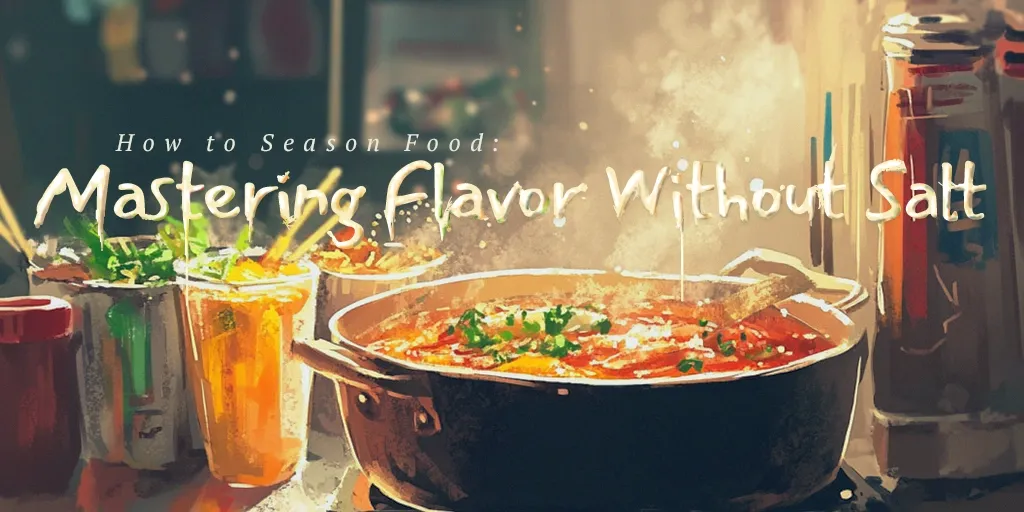
How to Season Food: Mastering Flavor Without Salt
Seasoning food is an essential culinary skill that elevates a dish from basic to extraordinary. Whether you’re a home cook or a professional chef, knowing how to season food properly is vital for creating balanced, flavorful meals. Seasoning is not just about adding salt and pepper—it’s about enhancing natural flavors and creating harmony between the ingredients.
In this post, we will explore the essential rules of seasoning, how to season food properly, and how to season without using salt. Whether you’re looking to reduce sodium intake or experiment with new flavor profiles, these tips will guide you in crafting delicious meals that satisfy your palate.
The 5 Essential Rules of Seasoning Food Properly

Before diving into salt-free seasoning options, it’s important to understand the fundamentals of seasoning food the right way. Here are five rules that will help you bring out the best in any dish.
1. Season Throughout the Cooking Process
Seasoning is not just something you do at the end of cooking. Adding flavor in stages ensures a well-balanced taste that permeates the entire dish. Start by seasoning your ingredients at the beginning, and then adjust the flavors as you go. For example, when making a soup, you might add herbs and spices early on, taste midway, and then fine-tune the seasoning toward the end.
This gradual seasoning allows the ingredients to absorb the flavors fully, making the final result more cohesive. Remember, you can always add more seasoning, but it’s hard to take it away once it’s in the dish!
2. Use Fresh Herbs and Spices for Bold Flavor
Using fresh herbs and spices can dramatically improve the flavor of your dish. Dried spices are potent, but fresh herbs like basil, cilantro, parsley, or thyme can provide a vibrant and aromatic element that dried varieties can’t match. Fresh herbs tend to lose flavor when cooked for too long, so add them near the end of the cooking process to retain their bright notes.
Ground spices should be added early in the cooking process to give them time to bloom and release their oils. Whole spices, on the other hand, are best toasted lightly before grinding and adding to your recipe to unlock their full flavor potential.
3. Balance Flavors: Sweet, Sour, Bitter, Salty, and Umami
Seasoning is not just about salt—it’s about creating a balance between all the flavor elements: sweet, sour, bitter, salty, and umami. Each one plays a role in rounding out a dish:
Sweet: Add a touch of sugar, honey, or maple syrup to counteract bitterness.
Sour: Incorporate citrus juice, vinegar, or other acidic elements to brighten the dish.
Bitter: Coffee, dark chocolate, and certain greens can add depth.
Salty: Salt enhances the natural flavors of food (but can be substituted, as we’ll discuss below).
Umami: Foods like mushrooms, soy sauce, and tomatoes are rich in umami, providing a savory, mouth-filling quality.
Understanding how these flavors interact allows you to fine-tune your dish to perfection.
4. Taste as You Go
One of the most common seasoning mistakes is not tasting the food as you cook. This is essential for ensuring that your seasoning is on point. As your dish simmers, stews, or sautés, flavors change and develop. A dish that tastes too strong or underwhelming at one stage can be adjusted at another.
Before serving, always taste the final product and make last-minute adjustments with spices, herbs, or acids.
5. Know Your Salt: When and How to Use It
Salt is one of the most important seasonings in cooking because it enhances other flavors. However, not all salts are created equal, and knowing when and how to use them can make a big difference in your dish.
Kosher salt is a go-to for many chefs because it dissolves quickly and evenly.
Sea salt adds texture and can be sprinkled over food as a finishing touch.
Flavored salts, such as smoked or herb-infused varieties, can be used to add complexity to a dish.
If you’re looking to reduce your sodium intake, it’s still essential to understand salt’s role, so you can find ways to replace its impact with other ingredients.
How to Season Food Without Salt

For many, reducing salt intake is a health necessity, but that doesn’t mean you have to sacrifice flavor. Seasoning without salt can still bring out incredible taste in food by relying on alternative ingredients and techniques. Here are some strategies for seasoning food without using salt:
1. Boost Umami
Umami is often described as the “fifth taste,” and it’s naturally savory and satisfying. By using umami-rich ingredients, you can compensate for the absence of salt and create deep, full-bodied flavors.
Mushrooms, especially dried varieties like shiitake, are packed with umami and can be added to soups, stews, and stir-fries.
Soy sauce or tamari (which is often lower in sodium) can be a great replacement for salt in Asian-inspired dishes.
Tomatoes, particularly sun-dried, can enhance a dish with a rich, tangy quality.
Parmesan cheese provides both umami and a salty flavor, making it a great addition to pasta, salads, or roasted vegetables.
2. Use Citrus and Vinegar for Brightness
Citrus juice and vinegars provide a sharp, acidic contrast that can lift a dish in much the same way salt does. A squeeze of lemon or lime juice can instantly brighten a stir-fry, salad, or piece of grilled fish. Vinegars, such as apple cider, red wine, or balsamic, add complexity and a slight sweetness that can help balance flavors.
For instance, instead of sprinkling salt on roasted vegetables, try finishing them with a drizzle of balsamic vinegar or a squeeze of fresh lemon juice.
3. Add Aromatics for Depth
Onions, garlic, ginger, and shallots are powerful aromatic ingredients that build flavor without the need for salt. Sautéing them in olive oil or butter can create a strong base for many dishes, from soups to curries.
Roasting whole heads of garlic, or caramelizing onions, intensifies their sweetness and adds a rich, savory depth to your food. These techniques allow you to replace salt with layers of flavor from natural ingredients.
4. Spice It Up
Spices are your best friends when seasoning food without salt. Many cuisines—such as Indian, Mexican, and Middle Eastern—rely on spices to create complex, flavorful dishes without heavy use of salt. Consider using:
Cumin, coriander, and curry powder for warmth and earthiness.
Paprika and cayenne for a smoky, spicy kick.
Turmeric and ginger for vibrant, aromatic notes.
Spice blends such as garam masala or za’atar can also be a convenient way to introduce multiple flavors into a dish with just a pinch.
5. Fresh Herbs: The Natural Flavor Enhancers
Herbs are a fantastic way to boost the flavor of food without reaching for the salt shaker. Fresh herbs like basil, cilantro, dill, and mint can add bright, zesty flavors to your meals. Adding these right at the end of cooking ensures their fresh flavors stay intact.
You can also experiment with making herb-infused oils or vinegars to drizzle over salads or grilled meats for an extra burst of flavor.
Final Thoughts: How to Properly Season Food Without Salt
Seasoning food is an art, and like any skill, it takes practice to master. By focusing on building layers of flavor through herbs, spices, and umami-rich ingredients, you can achieve delicious, satisfying dishes without relying on salt.
Whether you’re cutting down on sodium for health reasons or just want to explore new ways to enhance your meals, these techniques will help you season food properly while keeping it flavorful and exciting. Remember, seasoning is all about balance—finding the right combination of ingredients to create a dish that truly shines.
By using these tips, you can confidently season food without salt and still enjoy rich, satisfying meals every day.
To explore delicious fall menu ideas that elevate seasonal dining experiences, check out our section on Delicious Fall Menu Ideas for Restaurants: Elevating Seasonal Dining Experiences.





